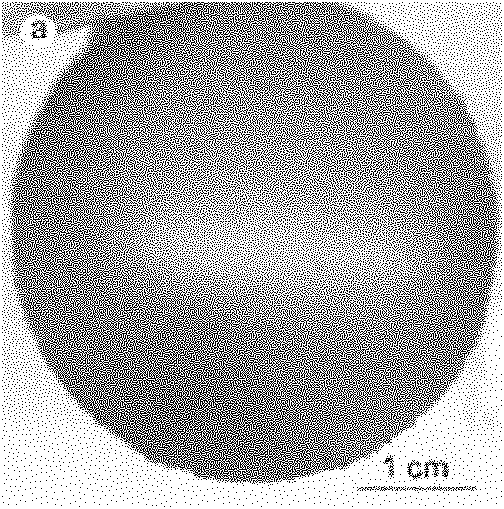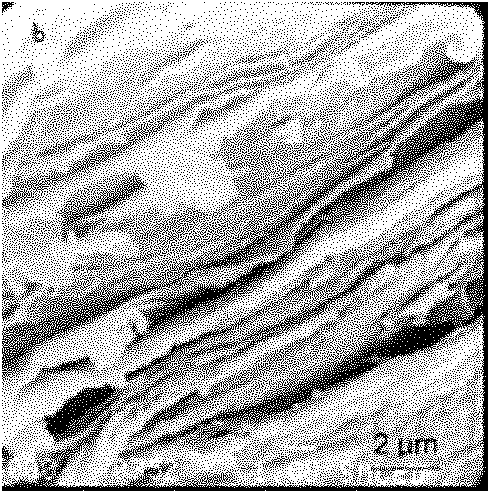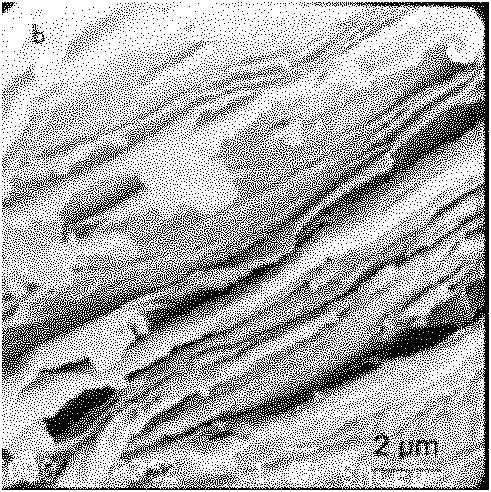Method for preparing counter electrode of dye-sensitized solar cell
A technology of solar cells and dye sensitization, applied in the field of solar cells, can solve the problems of high platinum price, small specific surface area and unfavorable industrial application of batteries, etc., and achieve low production cost, good thermal conductivity and mechanical properties, and good electrical conductivity Effect
- Summary
- Abstract
- Description
- Claims
- Application Information
AI Technical Summary
Problems solved by technology
Method used
Image
Examples
Embodiment 1
[0020] Embodiment 1: the preparation of the counter electrode of the universal conductive carbon film based on monolayer graphene
[0021] 1) Prepare single-layer graphene by chemical oxidation method. 10 g of graphite and 7 g of sodium nitrate (analytical pure) were added to the flask, and then 500 mL of concentrated sulfuric acid (analytical pure) was added. Then in an ice-water bath, slowly add 40 g of potassium permanganate while stirring, the addition time is controlled at 2 hours, and then kept for 2 hours to cool down to room temperature. Stir at room temperature for 10 days, the reaction solution first turns green, then dark brown, and finally brick brown, and viscous, slowly add the reaction solution to 1000mL of 5wt% dilute sulfuric acid, the addition time is controlled at 2h, keep stirring , the temperature was controlled at 98°C. The reaction solution was stirred at this temperature for another 2 h, and then cooled to 60 °C. Add 30 mL of hydrogen peroxide (30% a...
Embodiment 2
[0025] Example 2: Preparation of a transparent conductive carbon film counter electrode based on single-layer graphene
[0026] 1) prepare single-layer graphene according to the method of embodiment 1 step 1). Add 1g of single-layer graphene into water, and process it with 500W ultrasonic treatment for 30 minutes to completely dissolve it; the concentration range of graphene solution is 0.5mg / ml;
[0027] 2) The monolayer graphene aqueous solution is coated on the surface of the glass substrate by the method of spin coating, and placed at room temperature for 72h; after drying, the film of the monolayer graphene is obtained;
[0028] 3) then placing the glass substrate loaded with a single-layer graphene film in an airtight container, and fumigation with hydrazine hydrate steam for 24h to obtain a single-layer graphene film reduced by hydrazine steam;
[0029] 4) Place the glass substrate of the single-layer graphene film reduced by hydrazine vapor in a tube furnace, and bake...
Embodiment 3
[0030] Example 3: Preparation of a general-purpose conductive carbon film counter electrode based on multilayer graphene
[0031] 1) Prepare multilayer graphene according to the method reported in the literature (carbon, 2004, 42, 2929), and the obtained product is centrifuged to obtain a mixture of 2 layers of graphene. Add 1g of multi-layer graphene into water, and process it through 500w ultrasonic treatment for 60min to completely dissolve it; the concentration range of graphene solution is 1mg / ml;
[0032] 2) Add 0.5g sodium borohydride, stir, and react at 80°C for 2h, the solution turns from brown to black, and the reduced graphene dispersion is obtained; after mixing the above graphene dispersion with an aqueous carrier, use a screen to The printing method is printed on the surface of the conductive glass substrate to form a film, and placed at room temperature for 48 hours; after drying, a multi-layer graphene film is obtained;
[0033] 3) Then, under the protection o...
PUM
 Login to View More
Login to View More Abstract
Description
Claims
Application Information
 Login to View More
Login to View More - R&D
- Intellectual Property
- Life Sciences
- Materials
- Tech Scout
- Unparalleled Data Quality
- Higher Quality Content
- 60% Fewer Hallucinations
Browse by: Latest US Patents, China's latest patents, Technical Efficacy Thesaurus, Application Domain, Technology Topic, Popular Technical Reports.
© 2025 PatSnap. All rights reserved.Legal|Privacy policy|Modern Slavery Act Transparency Statement|Sitemap|About US| Contact US: help@patsnap.com



